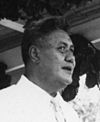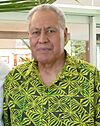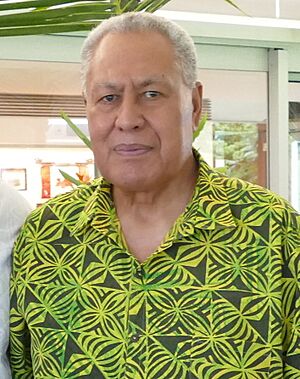O le Ao o le Malo facts for kids
Quick facts for kids O le Ao o le Malo of theIndependent State of Samoa |
|
|---|---|

|
|

|
|
| Style | His Highness |
| Residence | Vailele |
| Seat | Apia |
| Appointer | Legislative Assembly |
| Term length | Five years, renewable once |
| Constituting instrument | Constitution of Samoa |
| Inaugural holder |
|
| Formation | 1 January 1962 |
| Deputy | Members of the Council of Deputies |
| Salary | US$82,000 annually |
| Website | www.samoagovt.ws |
The O le Ao o le Malo is the official title for Samoa's head of state. In the Samoan language, it means "chief of the state." This role is mostly ceremonial, like a president who represents the country.
When Samoa's constitution was first created, people expected that future heads of state would be chosen from four important traditional leaders called tamaʻāiga. However, this is not a strict rule in the constitution. This means Samoa is a parliamentary republic, where people elect their leaders, rather than a constitutional monarchy, which has a king or queen. The government calls the O le Ao o le Malo a "ceremonial president." Like traditional leaders, the person holding this office is called "His Highness."
A group called the Council of Deputies helps the head of state. They step in if the head of state cannot do their job. The current head of state is Tuimalealiʻifano Vaʻaletoʻa Sualauvi II. He was first elected for a five-year term in 2017 and then re-elected in 2022.
Contents
History of Samoa's Head of State
Samoa's constitution, written in 1960, said that the Legislative Assembly would elect the head of state for five-year terms. But there was a special rule for the first two leaders: Tupua Tamasese Meaʻole and Malietoa Tanumafili II. They were chosen to serve for life when Samoa became independent on January 1, 1962. These two leaders came from important family lines, the Tupua Tamasese and Malietoa. These families had a long history of competition for leadership.
These two leaders were known together as O Ao o le Malo. If one of them passed away, the other would continue as the only head of state. Tupua Tamasese Meaʻole died in 1963. This left Malietoa Tanumafili II as the sole head of state until he passed away in May 2007.
After Malietoa Tanumafili II's death, the Legislative Assembly held its first election for the head of state in June 2007. Tui Ātua Tupua Tamasese Efi was chosen. He had previously served as Prime Minister twice and was the son of Tupua Tamasese Meaʻole.
The fourth and current head of state, Tuimalealiʻifano Vaʻaletoʻa Sualauvi II, is related to important historical figures. He has held the important traditional title of Tuimalealiʻifano since 1977.
In 2019, the Samoan government changed the constitution. This change limited the head of state to serving no more than two terms. The former official home of the head of state was the house of writer Robert Louis Stevenson in Vailima. However, it was damaged by cyclones in the 1990s and is now the Robert Louis Stevenson Museum.
Who Can Be Head of State?
Article 18 of Samoa's constitution explains who can become the head of state. A person must:
- Be able to be elected as a member of the Legislative Assembly.
- Have any other special skills or qualities that the Legislative Assembly decides are important.
- Not have been removed from the office before because of bad behavior or illness.
How Long is the Term?
The head of state is elected by the Legislative Assembly for five years. They can be re-elected only once. The first two leaders, Tupua Tamasese Meaʻole and Malietoa Tanumafili II, were exceptions to this rule. They were allowed to serve for life. The 2019 change to the constitution made sure that no head of state can serve more than two terms.
A head of state's term can end in a few ways:
- They can choose to resign (step down).
- The Legislative Assembly can remove them if they behave badly or become too sick.
- Two-thirds of the Legislative Assembly can vote to remove them. This vote needs to be suggested by at least a fourth of its members. There must be at least 14 days between the suggestion and the vote.
- Their term also ends if they pass away.
What Does the Head of State Do?
The head of state is a figurehead position. This means they have an important role in representing the country, but the real power is held by the Prime Minister. The head of state officially appoints the Prime Minister, based on the Legislative Assembly's choice.
While the head of state does not actively run the government, they have important duties. They can dissolve (close down) the Legislative Assembly. Also, no new law can be passed without their approval. This is similar to how a king or queen approves laws in a monarchy. They can also grant pardons, which means forgiving someone for a crime.
Elections for Head of State
There have been four elections for the head of state so far.
- The first election was on June 16, 2007. Tui Ātua Tupua Tamasese Efi was elected without anyone running against him.
- The second election was on July 19, 2012. Efi was nominated again and won.
- The third election was on June 30, 2017. Tuimalealiʻifano Vaʻaletoʻa Sualauvi II was elected without anyone running against him.
- The fourth election was on August 23, 2022. Sualauvi II was re-elected without anyone running against him.
List of Leaders
- Status
Denotes acting O le Ao o le Malo
-
- Symbols
Constitutional referendum As member of the Council of Deputies Died in office
| No. | Portrait | Name
(Birth–Death) |
Elected | Term of office | Political party | Prime minister(s) | ||
|---|---|---|---|---|---|---|---|---|
| Took office | Left office | Time in office | ||||||
| 1 |  |
Tupua Tamasese Meaʻole (1905–1963) |
1961 | 1 January 1962 | 5 April 1963 | 1 year, 94 days | Independent | Mulinuʻu II |
| 1 |  |
Malietoa Tanumafili II (1913–2007) |
1 January 1962 | 11 May 2007 | 45 years, 130 days | Independent | Mulinuʻu II Lealofi IV Tupua Kolone Alesana Tuilaʻepa |
|
| — |  |
Tui Ātua Tupua Tamasese Efi (born 1938) Acting O le Ao o le Malo |
— | 11 May 2007 | 20 June 2007 | 40 days | Independent | Tuilaʻepa |
| — |  |
Tuimalealiʻifano Vaʻaletoʻa Sualauvi II (born 1947) Acting O le Ao o le Malo |
11 May 2007 | 20 June 2007 | Independent | |||
| 2 |  |
Tui Ātua Tupua Tamasese Efi (born 1938) |
2007 2012 |
20 June 2007 | 21 July 2017 | 10 years, 31 days | Independent | Tuilaʻepa |
| 3 |  |
Tuimalealiʻifano Vaʻaletoʻa Sualauvi II (born 1947) |
2017 2022 |
21 July 2017 | Incumbent | 6 years, 20 days | Independent | Tuilaʻepa Mataʻafa |
Timeline of Leaders

Related Topics
- Politics of Samoa
- Prime Minister of Samoa
See also
 In Spanish: O le Ao o le Malo para niños
In Spanish: O le Ao o le Malo para niños


